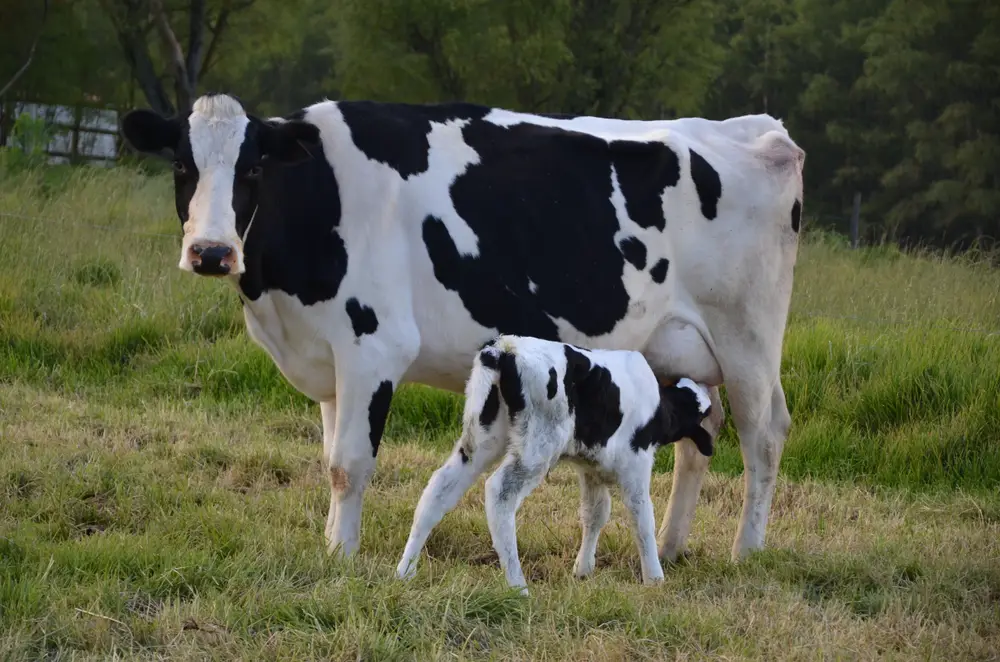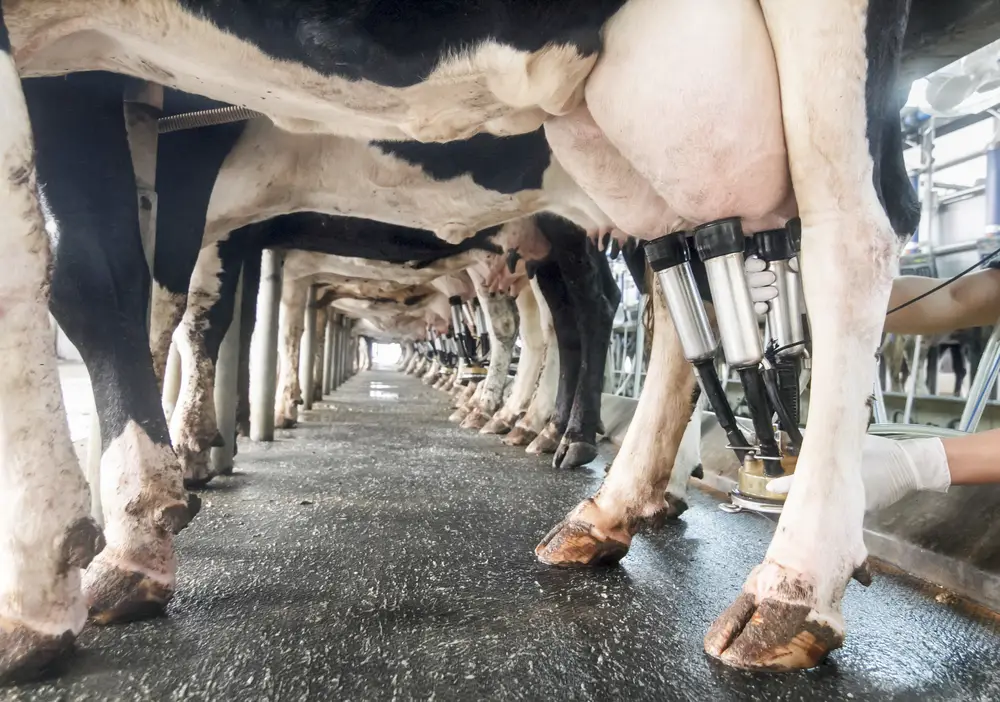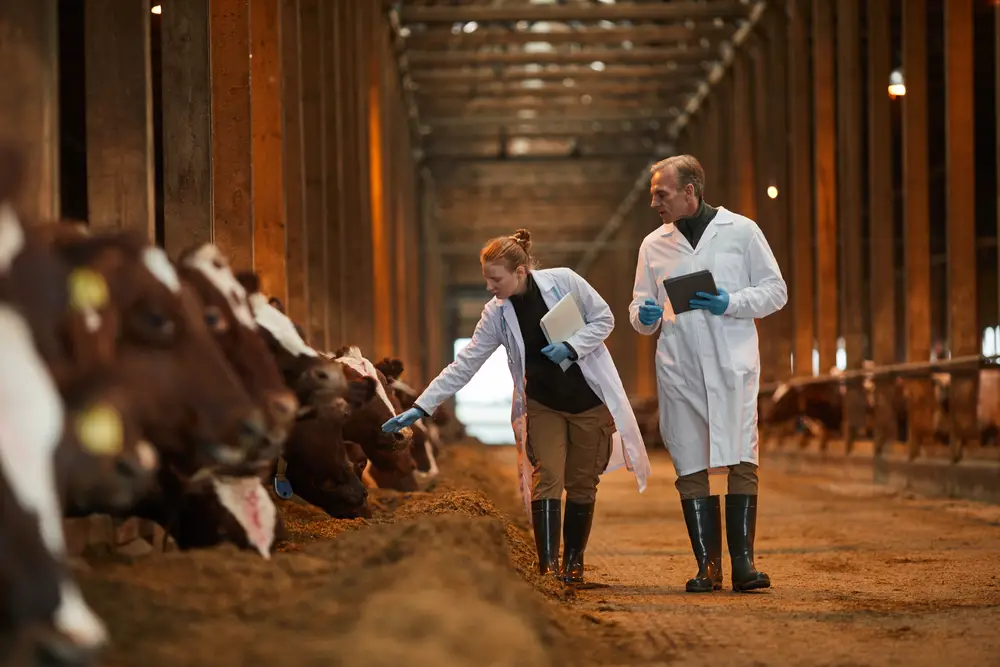Cows spend their entire lives (6 to 10 years) grazing on grass or forage and mothering baby calves. When they are too old to calve, cows are harvested for beef.
Cows live up to 20 years, but this type of lifespan is scarce on production farms, and cows dying of old age will only usually happen in family operations.
Beef cattle will not survive beyond three years unless there are special circumstances.
Table of Contents
Stages in Cattle Lifespans
Calf Life
The mother licks the newborn calf clean and encourages suckling by pushing the calf towards the udder. The calf then receives colostrum, the rich, creamy golden fluid its mother produces on one occasion immediately after birth. Colostrum provides nutrition and contains immunoglobulins to protect the calf while its immune system is still developing.
The farmer typically takes the calf away from the cow after the first few days so they can start milking the cow for human consumption. Cows usually give birth for the first time when they are about two to three years old. Calves stand almost immediately after birth.
Dairy farmers will sometimes buy female calves from a market at a few weeks old for rearing as replacement stock to replace older dairy production cows as they are culled. They may also buy replacements around a year and a half old, often just before they can become pregnant for the first time.
Bobby Calves
A bobby calf goes to slaughter immediately after birth or up to about a month old. Alternatively, male and surplus female calves provide veal or beef. The slaughter age for veal varies in different countries but is around five to seven months, or slightly older, in the UK. It is common for calves to be exported worldwide for rearing, typically at roughly two weeks old.
Male calves undergo castration at an age that’s dependent on the farmer’s preference. UK regulations state that only calves under eight days old may undergo castration using a ring placed around the scrotum that cuts off the blood supply. This method does not require any pain relief.
Calves stop drinking milk and move on to solid food (weaning) at eight weeks old, although some ranchers do this sooner to save money. Young cows have hay or barley straw to chew on as early as one or two weeks old, helping their stomachs develop.
Production Dairy Cattle Lifespans
Calving (first phase)
Time in the cycle: 6 to 8 months
The age heifers reach puberty depends on their breed, health, nutrition, and genetics. Heavier ones begin their cycle or estrus earlier and thus are ready to reproduce sooner than lighter ones. Consequently, heifers should display a progressive and substantial weight gain during rearing if farmers want to take full advantage of their fertility.
Proestrus precedes estrus and features the development of Graafian follicles, higher instances of estrogenic activity, and changes in vaginal and uterine mucosa.

As mentioned, the age a heifer reaches puberty depends on her breed on body weight, but she will be between 8 and 15 months old when puberty occurs. Farmers usually aim for their heifers to become pregnant at around 15 months of age, so they give birth at about two years old. Some may seek to induce earlier puberty, so calving can start before 2 years old, as they believe this increases production rates.
Properly-nourished beef heifers typically reach puberty between 9 and 12 months, whereas heifers on dairy farms take about three months longer. The Brahman breed of cattle can take up to 2 years. Pubescent heifers then start to have continuous estrous cycles around every three weeks.
Breeding (second phase)
Time in the cycle: 9 months
Breeding can start once the heifer has reached puberty. Most heifers will be at around 60% of their mature weight when they begin to exhibit estrous cycles.
Some beef females start to cycle at less than a year of age. This phenomenon is called precocious puberty and doesn’t happen often. This age is too young for a beef female to become pregnant because the birth canal has not fully developed.
During pregnancy, a heifer stays in her rearing group. A cow is not fully mature until she reaches about three years old, so during her gestation period of about 283 days, her diet needs careful monitoring to ensure that she is still growing.
The average age for a cow to calve is two years old, so, with a standard gestation period of just over 9 months, you should look towards getting your heifers pregnant at 15 to 16 months.
Cycling must start at a year to 13 months for this to happen. Timing is crucial because a heifer will conceive much more quickly if she has had two or three cycles before insemination.
Heifers must reach half their projected body weight after a year and then be able to increase by a further 10 percent over the following three months. A heifer breeder’s business can succeed or fail depending on how they manage their fertility program and how conscientious they are with weight targeting and recording.
Post calving, the point at which a cow will start its next estrous cycle, depends on its physical and mental health, body weight, and nutrition. Follicular activity, i.e., estrogen creation, can resume after fewer than 10 days if the cow displays an increase in the production of a transient follicle-stimulating hormone within 5 days of birthing.
Well-nourished milk cows would normally recommence ovulation about two weeks after calving. A beef suckler cow would take approximately 30 days. Female beef cattle with poor physical characteristics might not ovulate for up to 100 days.
Lactation (third phase)
Time in the cycle: 9 months
The cow produces milk immediately after, or even just before, giving birth and will be milked once, twice, or even three times daily, depending on its productivity.

Farmers try to get their cows impregnated again within two months of her giving birth so that she produces one calf per year. However, a more typical time frame is for cows to give birth every 400 days.
Cows have a natural life expectancy of over 20 years, but slaughter ages vary considerably on commercial or factory farms. Farms with poor management, high-yielding cattle, or high disease rates will slaughter their animals at a much younger age, generally after four lactations (around 5 to 6 years old), but sometimes after two or three.
Production Beef Cattle Lifespans
Calf (first phase)
Time in the cycle: 6 to 8 months
The beginning stage of life for grass-finished and grain-finished cattle is the same for the first 8 to 10 months of the animal’s life. Beef cattle eat grass for at least the first half of their lives.
The natural way for a cow to have a calf is unassisted in an open field or pasture. However, if a rancher knows a cow is about to give birth, they will often bring the cow into a barn or shelter for two reasons.
The first reason is to protect the cow and the newborn calf from inclement weather, especially wind, rain, or extreme cold. Calves are often born in winter, and going from the womb’s warmth into the cold can cause sickness or even death. The second reason is to be on hand in the event of calving problems. In the event of breech birth, manual intervention is necessary to pull the calf out of the cervix and save the lives of both animals.
After birth, the calf will receive a brand or ear tag and nurse off of its mother for 6 to 8 months. Eventually, the calf starts to graze on grass with its mother until it is weaned from milk entirely. Up to this point, the lives of all beef cattle are the same, but after this, they will become breeding animals or be fed for beef production.
Bulls and Cows
Time in the cycle: 5 to 10 years
Once grass-pasture calves are weaned off of their mothers, farmers sort them into gender groups. Cows are heifers that have had a baby calf. Cows have a 9-month gestation period and typically have a calf every 12 months.
Cows spend their production lives (approximately 7 to 10 years) grazing on grass or forage and mothering baby calves. When they can no longer have calves, cows are harvested for beef.
When a bull can produce usable sperm, it has reached puberty. Although this age can vary according to breed, health, and nutrition, it usually happens at around one year of age.
Their breeding life is then about five years on average although hoof problems and injuries often shorten this lifespan.
Grass-Finished Beef Cattle (middle to final phases)
Time in the cycle: 6 months to 3 years
Once calves on grass pasture are weaned off their mothers, they are sorted into groups of bulls and heifers. The males will undergo castration and spend the remainder of their days grazing on grass until they are fat enough to harvest.
Grain-Finished Beef Cattle (middle phase)
Time in the cycle: 6 to 14 months

Once calves on grass pasture are weaned off of their mothers, they are sorted into groups (large and small, bulls or heifers) and sold to the next producer. The next 3 to 5 months are spent eating in a backgrounding feedlot. When the animals reach approximately 850 pounds, they are sorted by weight again and then sold to a finishing yard for fattening before market.
Grain-Finished Beef Cattle (final phase)
Time in the cycle: 4 to 6 months
This stage is similar to the middle stage except for the larger and richer dietary regimen.
Slaughter/Harvest of Beef Cattle (end stage)
Beef cattle in the US go to slaughter between 1 to 2½ years old. Steers on full feed (all they can eat grain with hay) will be butcher-ready at 14-18 months of age, while steers fed on grass only will go to the butcher at 26 to 28 months.
Extensively reared animals can sometimes go to slaughter at 5 years old. Dairy cattle generally last until about 5, when they are sent to slaughterhouses.
Variations of Lifespan
As previously mentioned, veal calves will be slaughtered very early, usually between 5 to 7 months.
Lameness, mastitis, and cows not producing enough milk are common reasons for early culling. Cows whose milk production has ceased to make them economically viable will be culled straight away. This drop in milk yield can be due to the cow’s teeth falling out or no longer being fit to chew and break down forage.
A bull used for artificial insemination can have its useful lifespan shortened if it develops hoof problems, arthritis, or excessive fat around the scrotum. Bulls are naturally aggressive and can sustain crippling injuries while fighting with rival males.
